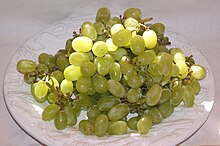| Sultana | |
|---|---|
| Grape (Vitis) | |
 Sultana (Thompson Seedless) grapes Sultana (Thompson Seedless) grapes | |
| Color of berry skin | Chartreuse |
| Species | Vitis vinifera |
| Also called | sultanina, Thompson Seedless, Lady de Coverly, oval-fruited Kishmish, İzmir üzümü |
| Notable regions | Aegean Region, Turkey |
| VIVC number | 12051 |
The sultana is a "white" (pale green), oval seedless grape variety also called the sultanina, Thompson Seedless (United States), Lady de Coverly (England), and oval-fruited Kishmish (Iraq, Iran, Israel, Palestine, Pakistan, Afghanistan, India). It is also known as grape of İzmir or Manisa in Turkey since this variety has been extensively grown in the region around those cities. It is assumed to originate from Asia Minor, which later became part of the Ottoman Empire.
In some countries, especially Commonwealth countries, the name sultana is used for the raisin made from it or larger seedless grapes; such sultana raisins are often called sultanas or sultanis.
History
Originating from Asia Minor, now part of modern-day Turkey and Iran, the Sultana grape was cultivated for its seedless nature and sweet flavor.
The Ottomans took the sultana grape variety to the island of Crete in the 19th century.
Etymology
Thompson Seedless refers to William Thompson, a viticulturist who was an early grower in California and is sometimes credited with introducing the variety. According to the US Code of Federal Regulations, the two names are synonymous. Virtually all of California raisin production (about 97% in 2000) and roughly one-third of California's total grape area is of this variety, making it the single most widely planted variety. Before Thompson Seedless became dominant, Muscat of Alexandria was a primary raisin grape in California.
Raisins
Main article: Raisin Close-up of golden sultana raisins
Close-up of golden sultana raisins Dark sultana raisins
Dark sultana raisins
In the US, most raisins, including those with the typical dark brown color, are made from the sultana grape, the Thompson Seedless. The term "sultana" refers to golden-colored dried grapes, which may also be called "golden raisins" (such as marketed by Sun-Maid, a California-based raisin grape growers' co-op and legacy brand). Any grape may be used to produce golden raisins, and any kind of golden raisins from any kind of grape may be marketed as "sultanas". Moreover, the golden color may come from a treatment with sulfur dioxide rather than traditional drying and preservation methods. Most nonorganic sultana grapes in California and elsewhere are treated with the growth-inducing plant hormone gibberellin. In other grapes, gibberellin is released by the seeds.
Other uses
The sultana grape is also used to make white wine, in which use it is known for its "sweet blandness". It is referred to as a "three-way grape" because it is used as a table grape, to make raisins and to make wine. In the United States, it is the base for wine generically called "chablis". This wine is named for the Chablis region of France, but it is not a true Chablis wine. In the EU, "Chablis" wine must be made from the Chardonnay grape produced in the region of the Yonne département.
End uses include:
- Manufacturing industries such as bakeries and breakfast cereal producers
- Supermarkets
- Dairy products such as yogurt and ice-creams
- Salads and desserts
Its triple use has made the Thompson Seedless the most planted grape in California.
Sultana grape juice was fraudulently sold as being of Chardonnay grapes in Australia for winemaking, as Sultana grapes cost less. The fraud was discovered in 2003 by the Australian Wine and Brandy Corporation. It was considered the largest case of wine deception in Australian history.
Sultaniye wines
Sultaniye wines are dry and semi-dry, light-bodied wines produced in Turkey. Sultaniye grapes used in winemaking are mainly grown at Denizli and Manisa in the Aegean Region of Turkey. Sultaniye grapes are consumed as table grapes and raisins and used in winemaking. The Semillon and Sultaniye wines from the Marmara Region of Turkey attract attention not only in the local market but also in international markets.
Sultaniye Rakı
Sultaniye is the most common variety for rakı production due to its high volume of cultivation and traditional taste. Also in recent years, due to increasing market demand for product differentiation, companies led to use various varieties and methods to gain competitive advantage in the growing sector of Turkish alcoholic beverages. This trend emerges from the desire to revive old, rare, and local varieties.
References
- ^ Bioletti, Frederic T. (1918). "The Seedless Raisin Grapes". Bulletin of the California Agricultural Experimental Station (298): 86. Retrieved 2011-12-10.
- Osmanlı İmparatorluğu ve Girit bunalımı (1896–1908) at Google Books
- ^ "Sultana". American Heritage Dictionary (4th ed.). 2000. Archived from the original on 2005-09-09.
- ^ Appellation America. "Thompson Seedless". Retrieved 2006-06-15.
- "United States Code of Federal Regulations, title 7, section 999.300". Retrieved 2006-06-15.
- United States Department of Agriculture. "California Grape Acreage Report, 2002 Crop". Archived from the original on 2006-04-09. Retrieved 2006-06-15.
- Christensen, Peter (2000). Raisin Production Manual (PDF). UCANR Publications. p. 38. ISBN 9781879906440.
- "United States Code of Federal Regulations, title 7, section 989.7". Retrieved 2006-06-15.
- Gibberellin and Flame Seedless grapes Archived 2006-12-06 at the Wayback Machine from a University of California, Davis website Retrieved on 2009-04-13
- ^ "Wine Glossary - Words that start with T". Retrieved December 22, 2016.
- Sultanas Archived 2013-10-23 at the Wayback Machine - Bestsultanas.com, London, England
- Love, Tony (April 9, 2010). "Winery sold sultanas as chardonnay". The Advertiser. Retrieved September 15, 2024.
- ^ Cabaroglu, T.; Selli, S.; Kafkas, E.; Kurkcuoglu, M.; Canbas, A.; Baser, K. H. C. (2005). "Determination of Volatile Compounds in Sultaniye Wine by Solid-Phase Microextraction Techniques". Chemistry of Natural Compounds. 41 (4): 382–384. doi:10.1007/s10600-005-0157-0. S2CID 35272688.
- ^ George, Rosemary (2 June 2013). "Turkish Wine Has Vast Potential, Exciting Flavors". Zester Daily. Archived from the original on 6 October 2014. Retrieved 1 October 2014.
- Girişimcilik, p. 82, at Google Books